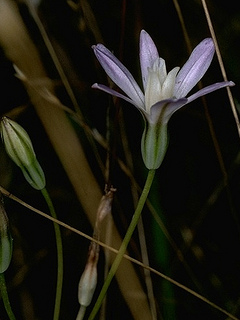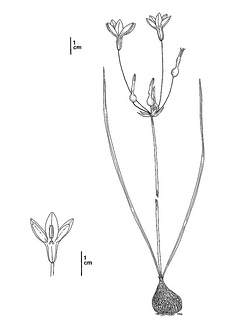(Brodiaea pallida)
 Brodiaea pallida. Photo © John Game.
Brodiaea pallida. Photo © John Game.
 Brodiaea pallida. CDFW illustration by Mary Ann Showers. (Click to enlarge)
Brodiaea pallida. CDFW illustration by Mary Ann Showers. (Click to enlarge)
Chinese Camp brodiaea is a California endangered plant species, which means that killing or possessing plants from wild populations is prohibited by the California Endangered Species Act (CESA). This species is also listed as threatened under the federal Endangered Species Act. Chinese Camp brodiaea is an herbaceous perennial in the Brodiaea family (Themidaceae) that grows to a height of four to twelve inches. It produces linear basal leaves from an underground corm, and terminal clusters of lilac or purple flowers that typically open in late May to early June. This species has been found in rocky, seasonally intermittent wet creek beds, where the hydrology is rainfall dependent. An analysis of this species’ soil associations has not been conducted, but it has been reported to grow on clay soils derived from serpentine or other volcanic origin. At the time of this webpage posting, the California Natural Diversity Database reports five extant occurrences of Chinese Camp brodiaea. The type locality is located in Tuolumne County near the town of Chinese Camp, and the other reported occurrences are located in southern Calaveras County along Little Johns, Sawmill and Black creeks near the town of Copperopolis.
The primary threats to Chinese Camp brodiaea include destruction and modification of habitat, and the vulnerability of small populations to extirpation resulting from catastrophic events and possible lack of genetic diversity. All occurrences of this species are located on private lands where no protections are in place for this species in perpetuity. The U.S. Fish and Wildlife Service 5-Year Review (PDF) conducted in 2012 indicates that residential development is in various stages of planning at locations for all populations, but the U.S. Fish and Wildlife Service does not consider this threat to be imminent.
Recommended actions to conserve Chinese Camp brodiaea include coordinating with private landowners to determine the extent of the existing populations and to monitor the status and trends of this species to estimate population sizes, number and distribution of populations, and whether the populations are stable, increasing, or declining. In addition, seed should be collected and placed into long-term storage at a qualified seed banking facility affiliated with the Center for Plant Conservation. Surveys should also be conducted in suitable habitat to determine if additional populations exist.
CDFW may issue permits for Chinese Camp brodiaea pursuant to CESA, and you can learn more about the California laws protecting Chinese Camp brodiaea and other California native plants. Populations of Chinese Camp brodiaea occur in CDFW’s North Central Region and Central Region. More information is also available from the U.S. Fish and Wildlife Service Species Profile for Chinese Camp Brodiaea.
Updated 01/14/2014